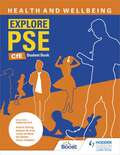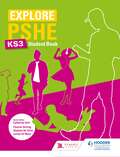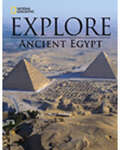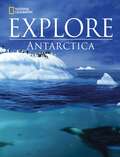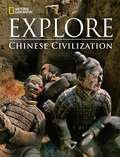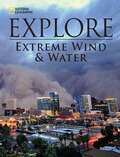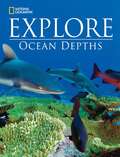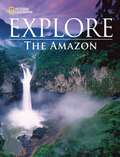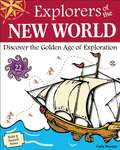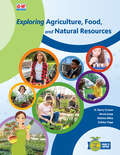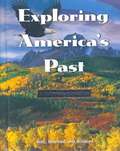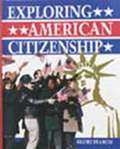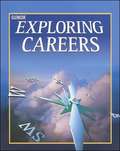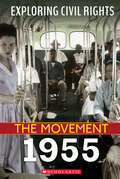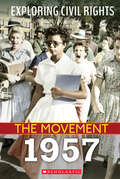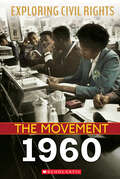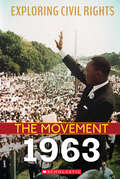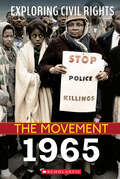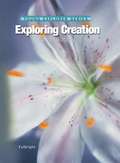- Table View
- List View
Explorations in Literature (America Reads) Classic Edition
by Nancy C. Millett Raymond J. Rodrigues'Explorations in Literature' has six units containing short stories, poetry, plays, and nonfiction. A seventh unit is made up of Greek myths. The eighth unit consists of a novel, The Call of the Wild.
Explore PSE: Health and Wellbeing for CfE Student Book
by Ian Geddes Calum Campbell Stephen De Silva Pauline Stirling Lesley de MezaSyllabus: CfE (Curriculum for Excellence, from Education Scotland) and SQALevel: BGE S1-3 (Second, Third and Fourth Levels), National 4 and National 5Subject: PSE (Health and Wellbeing)Empower Scotland''s young people to feel prepared for the opportunities and challenges of adult life.Exploring topics such as mental health, sex, identity, community and planning for your future, this book develops students'' life skills, knowledge and resilience as they learn about themselves and others.> Create a supportive environment where sensitive issues can be discussed confidently and constructively, using the book to provide stimulus material and structure> Follow an active learning approach with starter activities to get students thinking, visual sources and written extracts to encourage conversations, and hundreds of activities for individual, pair and group work> Monitor students'' progress through learning outcomes for each lesson/series of lessons and numerous activities that create opportunities for assessment for learning and evidence of achievement> Suit your students and your timetable, with topics that can be covered in any order and double-page spreads that can be delivered across one or two lessons> Rest assured that all content in the book is linked to the CfE Benchmarks and Experiences & Outcomes for Health and Wellbeing: Personal and Social Education, as well as the GIFREC and SHANARRI principles
Explore PSHE for Key Stage 3 Student Book
by Stephen De Silva Pauline Stirling Lesley de MezaDevelop your students' skills and understanding of PSHE and encourage an active learning approach, all whilst providing essential coverage of the 2020 statutory guidelines.The flexible design of this KS3 student book is compatible with whichever way your school delivers PSHE. User-friendly for both experienced PSHE Leads and for non-specialist teachers, it is packed full lesson outcomes and starter sections, as well as lot of activities students can get involved in.- Provide the right level of knowledge and understanding of PSHE education students need with this KS3 Student Book that has topic suitability for this age range- Learning outcomes at the start of every lesson, along with a short activity to introduce students to the topic and get them thinking provides an easy way in to every lesson- Source-based activities support an activity-based learning scheme that is accessible to students of all abilities
Explore the Bible: The Life of Christ Student Textbook
by Purposeful DesignThis book helps students explore Jesus' life through 40 individual lessons incorporated into a student textbook.
Explore: Antarctica (National Geographic Explore Series)
by National Geographic LearningNIMAC-sourced textbook
Explore: Chinese Civilization (National Geographic Explore Series)
by National Geographic LearningNIMAC-sourced textbook
Explorers of the New World
by Tom Casteel Carla MooneyExplorers of the New World: Discover the Golden Age of Exploration offers a fascinating look at the explorers and their voyages during the Age of Exploration and Discovery. Readers ages 9-12 can delve into the expeditions of Vasco da Gama, Christopher Columbus, Ferdinand Magellan, John Cabot, Hernán Cortés, and more. Using common household items and minimal supervision, kids enjoy 22 hands-on activities to help them learn about these legendary explorers and their voyages. Discover how the adventures of a few people 500 years ago changed world history.Projects include creating and using a compass, learning to tie a sailor's knot, and baking and eating sea biscuits. Along with detailed, step-by-step instructions for each project, Explorers of the New World includes biographical sidebars, engaging illustrations, interesting facts, and vocabulary words that allow kids to experience this era in a fun, interactive way.
Exploring Agriculture, Food, and Natural Resources
by D. Barry Croom Kevin Jump Melissa Riley Ashley YoppExploring Agriculture, Food, and Natural Resources introduces middle school students to AFNR literacy to build excitement for the wide variety of opportunities in agricultural education and careers as they develop interpersonal skills, gain hands-on immersion in STEM, and begin planning a Supervised Agricultural Experience. Built to meet the needs of exploratory courses, seventy-six lessons are organized into twelve, flexible units that can be assigned to accommodate a variety of timeframes, interests, or grade levels. This text is expertly designed for young learners with engaging photographs narrated by colorful characters. Agriculture educator, Mrs. Lopez, introduces each lesson with reflective questions and connects students with ten additional, diverse characters spanning the agricultural career pathways. Students learn concepts in relation to how they may be used in a variety of careers from greenhouse manager to microbiologist, or national park ranger to supply chain specialist.
Exploring America's Past
by John A. GarratyAmerican beginnings (Beginnings-1763): Worlds meet; Empires in the Americas; The English colonies; Colonial life and government -- New American nation (1755-1801): Americans seek independence; Forming a new nation; Launching the United States -- Building a strong nation (1790-1860): Expansion and war; The North and manufacturing; The South and king cotton -- Seeking growth and change (1820-1860): Conflicts and reform; Americans expand west -- Division and reunification (1848-1900): Breaking apart; The Civil War; Reuniting the nation -- Rise of modern America (1850-1900): Western crossroads; Becoming an industrial nation -- America becomes a world power (1865-1920): Progressives and reform; Involvement in world affairs; America and the Great War -- Good times and world crises (1919-1945): A decade of change; The Great Depression; America and World War II -- Assuming global responsibilities (1945-1969): Returning to peace; Power and prosperity; Winds of change -- Modern America (1954-present): War in Southeast Asia; Searching for solutions; Republicans in power; The 1990s and beyond -- Reference section.
Exploring America, Part 1 (Columbus to Reconstruction)
by Ray NotgrassThis curriculum will guide you through the story of our country from the first European explorers to the present. We place great emphasis on original documents and speeches because these allow the participants in history to tell the story from their own perspective. This curriculum also introduces some of the great literature that Americans have produced: novels, short stories, autobiographies, memoirs, essays, poems, hymns, and other kinds of writing. The written and spoken word has a profound ability to move hearts and minds. This course also explores the significance of faith with regard to history. Faith is connected with history in two ways. First, people have often been motivated to act because of their faith in God. For instance, faith motivated the Pilgrims on the Mayflower to seek a new land in which to live. Faith caused people to oppose slavery. Faith has been expressed often in the speeches and documents that Americans have produced. We recognize and highlight the importance of faith throughout the American story. A second way that faith should be connected to history is by looking at the overall story of American history through the eyes of faith. We encourage students to think about the faith lessons that they can learn from people and events in history. For instance, many God-fearing Americans owned slaves and had a strong prejudice against blacks. We need to understand what caused those Christian people to be blinded by their culture and how they missed the example of Jesus and the teaching of Scripture about this issue (see John 4:7-9, Galatians 3:28, and Ephesians 2:19). This might help us realize cultural blindnesses we suffer today. A study of history can inform, challenge, and strengthen our own faith. "
Exploring America, Part 2 (Late 1800's to Present)
by Ray NotgrassThis curriculum will guide you through the story of our country from the first European explorers to the present. We place great emphasis on original documents and speeches because these allow the participants in history to tell the story from their own perspective. This curriculum also introduces some of the great literature that Americans have produced: novels, short stories, autobiographies, memoirs, essays, poems, hymns, and other kinds of writing. The written and spoken word has a profound ability to move hearts and minds. This course also explores the significance of faith with regard to history. Faith is connected with history in two ways. First, people have often been motivated to act because of their faith in God. For instance, faith motivated the Pilgrims on the Mayflower to seek a new land in which to live. Faith caused people to oppose slavery. Faith has been expressed often in the speeches and documents that Americans have produced. We recognize and highlight the importance of faith throughout the American story. A second way that faith should be connected to history is by looking at the overall story of American history through the eyes of faith. We encourage students to think about the faith lessons that they can learn from people and events in history. For instance, many God-fearing Americans owned slaves and had a strong prejudice against blacks. We need to understand what caused those Christian people to be blinded by their culture and how they missed the example of Jesus and the teaching of Scripture about this issue (see John 4:7-9, Galatians 3:28, and Ephesians 2:19). This might help us realize cultural blindnesses we suffer today. A study of history can inform, challenge, and strengthen our own faith. "
Exploring American Citizenship
by Globe FearonThe Student Texts and Student Workbooks provide helpful charts, tables, and maps that allow students to look closely at all critical aspects of U.S. government, including citizenship, the justice system, foreign policy, and much more. The book helps students understand the development of the government and the rights and laws of local, state, and federal governments.
Exploring American History
by John O'ConnorIn this book you will read the story of your country from its beginnings to the present day. The people who tell this story are called historians. You may wonder how historians find out what happened in the past. Historians are like detectives. They use many kinds of clues to learn about the way people lived and what they did in years gone by.
Exploring Careers (3rd Edition)
by Joan Kelly-Plate Ruth Volz-PattonThis completely revised middle school career education program, formerly titled Career Skills, motivates your students to investigate career opportunities they might pursue in the future.
Exploring Careers in Dentistry
by Jessica A. RickertDiscusses the profession of dentistry and offers advice to those interested in dentistry as a career.
Exploring Civil Rights: The Movement: 1955 (Exploring Civil Rights)
by Nel YomtovKey events of the Civil Rights Movement will be brought to life in this exciting and informative new series.The year 1955 saw a range of events that brought attention to the civil rights movement. In August, Emmett Till, a Black teenager, was brutally murdered in Mississippi. In December, Rosa Parks refused to give up her seat to a white man while riding on a bus in Alabama. Parks’ brave action resulted in the year-long Montgomery bus boycott, an event that brought transformational change to the city. These events and more sparked a movement that in the following years would bring Black youth to the forefront of much needed reform in the nation.The years from 1955 to 1965 are at the heart of the civil rights movement—from the Montgomery bus boycott to the Voting Rights Act. The contributions of key activists, including Rosa Parks, Dr. Martin Luther King Jr., John Lewis, Barbara Nash, and Malcolm X, are part of the narrative. Demonstrations of passive resistance and legal challenges were often met with bloodshed and violence against Black Americans fighting to end segregation and discrimination. Yet the courage of those yearning for equal opportunities under the law ultimately produced legislation affirming that every American should have the same constitutional rights, regardless of color, race, or gender.
Exploring Civil Rights: The Movement: 1957 (Exploring Civil Rights)
by Susan TaylorKey events of the Civil Rights Movement will be brought to life in this exciting and informative new series.1957 was a year of new beginnings and hope for a growing movement. In January, prominent civil rights leaders attended a historic meeting in Georgia with Dr. Martin Luther King Jr. at the helm. In September, as protests were heating up around the nation, a group of Black students, known as the Little Rock Nine, integrated Central High School in Little Rock, Arkansas. At the same time, activists’ push for legislation resulted in the passage of the Civil Rights Act of 1957. Progress toward equality for Blacks was slow, but people’s commitment to the movement continued to deepen by the year as the prospect of change seemed possible.The years from 1955 to 1965 are at the heart of the civil rights movement—from the Montgomery bus boycott to the Voting Rights Act. The contributions of key activists, including Rosa Parks, Dr. Martin Luther King Jr., John Lewis, Barbara Nash, and Malcolm X, are part of the narrative. Demonstrations of passive resistance and legal challenges were often met with bloodshed and violence against Black Americans fighting to end segregation and discrimination. Yet the courage of those yearning for equal opportunities under the law ultimately produced legislation affirming that every American should have the same constitutional rights, regardless of color, race, or gender.
Exploring Civil Rights: The Movement: 1960 (Exploring Civil Rights)
by Selene CastrovillaKey events of the Civil Rights Movement will be brought to life in this exciting and informative new series.The year 1960 was a turning point in the civil rights movement as young Black men and women became peaceful warriors for change. In February, four Black college students, known as the Greensboro Four, were refused service at a lunch counter in North Carolina. Their sit-in inspired similar protests across the country, demonstrating the ideals of civil disobedience and nonviolent resistance. In November, as the year drew to a close, the nation’s eyes were on Ruby Bridges, a Black first grader who bravely integrated the William Frantz Elementary School in New Orleans. Desegregation would create a crisis of law and order throughout the South as the decade continued.The years from 1955 to 1965 are at the heart of the civil rights movement—from the Montgomery bus boycott to the Voting Rights Act. The contributions of key activists, including Rosa Parks, Dr. Martin Luther King Jr., John Lewis, Barbara Nash, and Malcolm X, are part of the narrative. Demonstrations of passive resistance and legal challenges were often met with bloodshed and violence against Black Americans fighting to end segregation and discrimination. Yet the courage of those yearning for equal opportunities under the law ultimately produced legislation affirming that every American should have the same constitutional rights, regardless of color, race, or gender.
Exploring Civil Rights: The Movement: 1963 (Exploring Civil Rights)
by Angela ShantéKey events of the Civil Rights Movement will be brought to life in this exciting and informative new series.The year 1963 brought both violence and a speech that resonates today. In June, two Black students were blocked from registering for classes at the University of Alabama. Civil rights leaders responded with a historic protest. In August, 250,000 people gathered for the March on Washington as Dr. Martin Luther King Jr. delivered his “I Have a Dream” speech. The following month, a bomb planted by the Ku Klux Klan killed four girls at a church in Alabama. The extent of racism and discrimination was finally laid bare, as public sentiment for the movement swelled and change now seemed inevitable.The years from 1955 to 1965 are at the heart of the civil rights movement—from the Montgomery bus boycott to the Voting Rights Act. The contributions of key activists, including Rosa Parks, Dr. Martin Luther King Jr., John Lewis, Barbara Nash, and Malcolm X, are part of the narrative. Demonstrations of passive resistance and legal challenges were often met with bloodshed and violence against Black Americans fighting to end segregation and discrimination. Yet the courage of those yearning for equal opportunities under the law ultimately produced legislation affirming that every American should have the same constitutional rights, regardless of color, race, or gender.
Exploring Civil Rights: The Movement: 1965 (Exploring Civil Rights)
by Jay LeslieKey events of the Civil Rights Movement will be brought to life in this exciting and informative new series.The civil rights movement in 1965 was fraught with assassination, brutal attacks, and an attempt to deny Black Americans the right to vote. In February, Malcolm X, a Black religious leader and human rights activist, was slain. Bloody Sunday followed in March when 600 civil rights protesters attempted to walk from Selma to Montgomery, the capital of Alabama, to oppose the suppression of the Black vote. As a result, the Voting Rights Act of 1965 was ultimately signed into law in August. The civil rights movement succeeded in getting legislation passed, but the fight against racism, discrimination, and hatred was far from over.The years from 1955 to 1965 are at the heart of the civil rights movement—from the Montgomery bus boycott to the Voting Rights Act. The contributions of key activists, including Rosa Parks, Dr. Martin Luther King Jr., John Lewis, Barbara Nash, and Malcolm X, are part of the narrative. Demonstrations of passive resistance and legal challenges were often met with bloodshed and violence against Black Americans fighting to end segregation and discrimination. Yet the courage of those yearning for equal opportunities under the law ultimately produced legislation affirming that every American should have the same constitutional rights, regardless of color, race, or gender.
Exploring Creation with Botany
by Jay L. Wile Jeannie FulbrightThe book is written directly to the student, making it appealing to kids. Presenting science concepts in a conversational, engaging style makes science enchanting and memorable for your students. It also fosters a love for learning. This course is written for children between six and twelve years old. When the course is complete, this book will serve as an excellent reference for your family's future questions and studies in botany. As a result, this book is a life-long investment!

